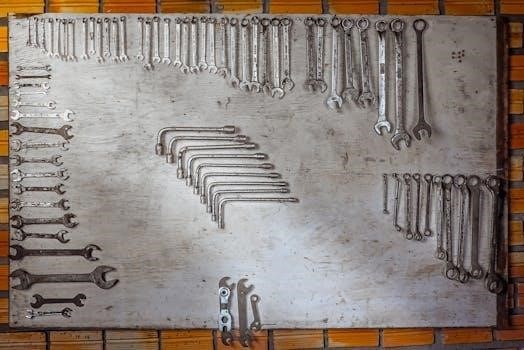
Hip Arthroscopy Rehabilitation Protocol Overview
This protocol serves as a guideline for post-operative rehabilitation following hip arthroscopy, particularly for labral repair and femoroacetabular impingement. It aims to guide clinicians through the recovery process, emphasizing tissue healing and gradual progression. The program should be tailored to individual surgical specifics.
Post-operative care following hip arthroscopy, particularly for labral repair, is crucial for a successful recovery. This initial phase focuses on protecting the surgical site and promoting healing of the labral tissue, which is known to be slow to recover. The primary objectives in the immediate post-operative period are to manage pain and inflammation using modalities like ice, often applied multiple times daily, and to limit activities that might stress the repaired area. Patients should be aware of precautions to ensure they do not compromise the healing tissues. It’s essential to follow the prescribed protocol closely and modify activities based on pain and swelling levels, as any increase in these symptoms should prompt a decrease in activity. The rehabilitation journey will be guided by the surgeon’s recommendations, but the physical therapist plays a vital role in each stage of the rehabilitation process.

Phase 1⁚ Initial Post-Operative (0-2 Weeks)
This initial phase, spanning from zero to two weeks post-surgery, prioritizes protecting the repaired labrum. Key focus areas include pain and inflammation management and starting gentle range of motion exercises, all within specified limits.
Goals of Phase 1
The primary goals during this initial post-operative phase, encompassing the first two weeks following hip arthroscopy, are centered around minimizing pain and inflammation. We aim to protect the integrity of the repaired labral tissue, recognizing its slow healing nature, by adhering to movement restrictions. A crucial objective is to initiate the restoration of range of motion within safe limits, gradually progressing towards normalized gait patterns, starting with assisted ambulation. We will also focus on controlling post-operative swelling through consistent use of ice and following prescribed protocols. Additionally, patient education regarding precautions and activity modifications is paramount. Achieving these goals sets the foundation for successful subsequent rehabilitation phases, facilitating optimal healing and functional recovery; This period will see the beginning of gentle exercises, carefully selected to avoid undue stress on the surgical site. Our primary focus is on the initial steps towards restoring function while protecting the labrum.
Key Precautions in Phase 1
During the initial phase of rehabilitation, several critical precautions must be observed to protect the healing labrum and ensure optimal recovery. Limiting hip flexion to 90 degrees for the first two weeks is crucial to prevent stress on the surgical site. Any activity causing pain or swelling should be immediately ceased, and the activity level reduced until the symptoms resolve. It’s vital to avoid aggressive movements, especially external rotation and abduction, which may compromise the repair. Patients must strictly adhere to prescribed weight-bearing restrictions to facilitate healing. Furthermore, it is essential to maintain clean and dry surgical dressings, changing bandages as directed to prevent infection. We also emphasize the importance of avoiding prolonged sitting and static postures to minimize hip joint stress. Strict adherence to these precautions is essential to prevent complications and support successful progression through the rehabilitation process. These measures ensure the labral repair is protected during early healing.

Phase 2⁚ Early Rehabilitation (2-6 Weeks)
This phase focuses on progressing range of motion within safe limits, normalizing gait patterns, and protecting the labral repair. Gradual increases in activity are introduced as pain and swelling subside, always respecting tissue healing.
Progression of Range of Motion
During the early rehabilitation phase, the progression of range of motion (ROM) is carefully managed to protect the healing labrum. Initially, hip flexion is limited, often to 90 degrees for the first two weeks post-op, with a gradual increase as tolerated. Emphasis is placed on achieving pain-free movement within these restrictions. Patients will start with gentle exercises, such as passive range of motion, followed by active-assisted and then active movements as comfort allows. The goal is to restore normal ROM without causing pain or increased swelling. Clinicians will instruct patients to increase ROM by approximately 5 degrees daily, while closely monitoring for any adverse reactions. It is crucial to avoid any aggressive stretching or movements that could compromise the surgical repair. Progression is always guided by the patient’s response and pain levels. Any increase in pain or swelling requires a temporary reduction in the ROM exercises. The focus remains on achieving functional movement within the safe zone to support healing and prepare for future strengthening. The goal is to achieve 90 degrees of flexion by the first follow up visit.
Gait Pattern Normalization
Normalizing gait patterns is a crucial aspect of the early rehabilitation phase following hip arthroscopy. Initially, patients often use assistive devices such as crutches to minimize stress on the operated hip. The focus is on achieving a pain-free, symmetrical gait pattern. This involves careful attention to weight-bearing status, which will be gradually increased as tolerated. Patients are taught proper techniques for ambulation, ensuring they avoid limping or compensatory movements. The goal is to re-establish a smooth and efficient walking pattern, with proper heel-to-toe progression and equal stride length. Physical therapists will closely monitor gait mechanics and provide cues and corrections as needed. As patients progress, they will transition from crutches to walking independently. Exercises are incorporated to improve balance and coordination, further supporting gait normalization; The aim is to restore a natural walking pattern that reduces stress on the joint and promotes proper healing. Any deviations from a normal gait are addressed early to prevent the development of compensatory habits.

Phase 3⁚ Intermediate Phase (6-10 Weeks)
This phase focuses on advancing strength and function. Strengthening exercises become more challenging, and functional activities are introduced. The goal is to prepare for more demanding tasks. Balance and coordination will also be addressed.
Strengthening Exercises
During the intermediate phase, strengthening exercises are crucial for restoring hip function and stability. These exercises should be implemented gradually, focusing on proper form and technique to avoid any strain or setbacks. The initial emphasis should be on building strength in the muscles surrounding the hip joint, including the gluteals, quadriceps, hamstrings, and core. Isometric exercises, where muscles contract without joint movement, are typically introduced first, progressing to isotonic exercises involving joint movement against resistance. Examples include side-lying leg raises, bridges, clamshells, and gentle squats; As strength improves, resistance bands or light weights can be incorporated to increase the challenge. Exercises should be progressed based on individual tolerance and response, closely monitoring for any pain or discomfort. It is important to maintain a controlled pace and avoid pushing through pain. Proper alignment and body mechanics should be emphasized throughout the exercises to ensure optimal muscle activation and injury prevention. Exercises should be performed in a slow, controlled manner, focusing on the quality of movement. The frequency and intensity of exercises can be increased gradually as the person progresses through the rehabilitation protocol, with specific guidelines provided by the therapist.
The introduction of functional activities marks a significant step in the rehabilitation process, bridging the gap between isolated exercises and real-world movements. This phase focuses on gradually incorporating activities that mimic daily life tasks, ensuring the hip can withstand the demands of everyday routines; These activities are introduced in a controlled manner, starting with simple movements and progressing to more complex ones, as tolerated. Examples include controlled walking on varied surfaces, stepping up and down small inclines, and gentle reaching movements. These activities are initially performed at a slower pace and with minimal resistance, ensuring that the hip joint is not overloaded. The focus is on maintaining proper form and alignment throughout each movement, to prevent any undue stress on the healing tissues. As the person’s confidence and strength increase, the activities can be performed more dynamically. The goal is to enable the individual to perform functional tasks without pain or discomfort, while maintaining good control and stability of the hip joint. Progression is dependent on individual tolerance and the response to these activities, with adjustments made to the exercise program as needed to ensure the best possible outcome. The therapist will provide specific instructions and guidance during this critical phase of rehabilitation.

Phase 4⁚ Advanced Rehabilitation
This phase focuses on preparing for a return to sport and long-term management. It includes sport-specific drills and addresses injury prevention strategies. The rehabilitation program is tailored to the individual’s specific needs and goals, ensuring a safe return to activity.
Return to Sport Considerations
The return to sport phase following hip arthroscopy and labral repair is a critical stage that requires careful planning and execution. Before athletes can return to full activity, they must demonstrate adequate strength, range of motion, and functional capacity. This involves a gradual progression from basic movement patterns to more complex, sport-specific exercises. Criteria for advancement often include the absence of pain, minimal swelling, and the ability to perform sport-specific tasks with good technique and without compensation. Athletes should be able to perform agility drills, jumping, and running at the necessary levels specific to their sport. The rehabilitation team must continuously monitor the athlete’s response to activity and adjust the program accordingly. Psychological readiness is also a crucial factor, as confidence is vital for successful reintegration into competition. A phased return to sport is recommended, beginning with low-impact activities before progressing to higher-impact drills and competitive play. This ensures that the athlete can return safely and minimizes the risk of reinjury. It is essential to consult with the surgeon and physical therapist to determine appropriate timelines and criteria for returning to sport.
Long-Term Management and Prevention
Long-term management following hip arthroscopy and labral repair is essential for sustained recovery and prevention of future issues. This phase focuses on maintaining strength, flexibility, and optimal movement patterns. Patients should engage in a regular exercise program that includes core strengthening, hip muscle strengthening, and flexibility exercises to maintain joint health and stability. It is crucial to continue to avoid activities that cause pain or discomfort and to make modifications as needed. Regular follow-up appointments with a physical therapist or healthcare provider may be beneficial to monitor progress and address any emerging issues. Patient education is vital, empowering individuals to manage their condition effectively. This includes understanding proper biomechanics, knowing when to modify activity, and recognizing signs of potential problems. A focus on overall health and wellness, including maintaining a healthy weight and following a balanced diet, can also contribute to long-term joint health. Preventative strategies involve consistently practicing good movement patterns and avoiding overtraining, especially in repetitive or high-impact activities. Long-term success depends on a proactive approach to maintaining hip health and function.